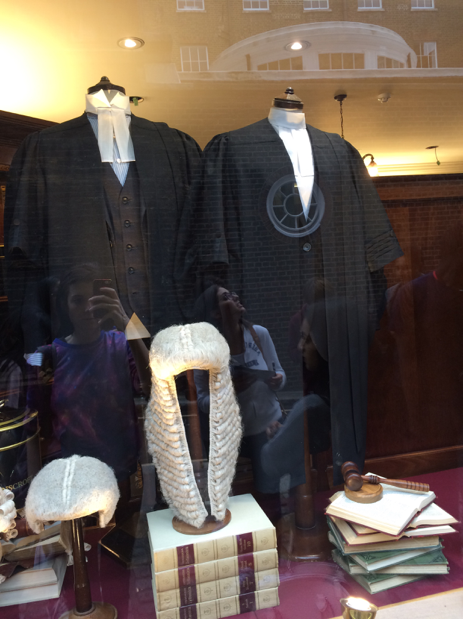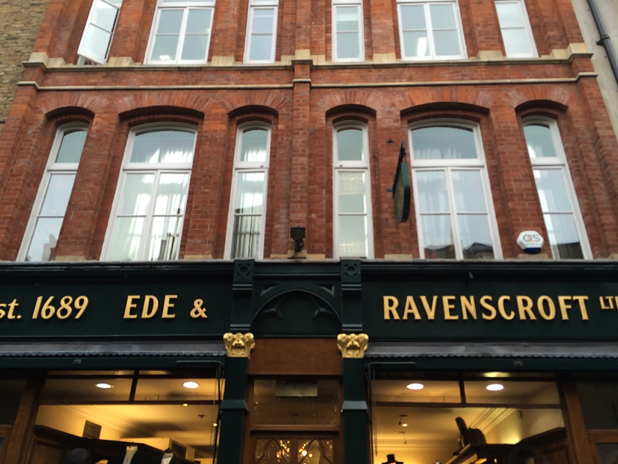Dressing The Judiciary
LLB1 student Sarah McIntosh writes this reflection on her experience during the #exploringthelaw exercise in induction week at City, University of London. Students followed various trails across legal London – tracking down specific buildings and doing some research, before writing a short post for the Lawbore Future Lawyer blog. Sarah was one of 21 winners chosen from across the LLB1 cohort.
 Last week I had the opportunity to take an adventure across legal London with my classmates (shout out to Group 19)! Although I have lived in London on and off for the past five years, I had never visited any of the locations we were asked to go to, so I was really excited to explore!
Last week I had the opportunity to take an adventure across legal London with my classmates (shout out to Group 19)! Although I have lived in London on and off for the past five years, I had never visited any of the locations we were asked to go to, so I was really excited to explore!
My favourite location by far was Ede and Ravenscroft. Established in 1689, it is London’s oldest tailor and robe maker. I was immediately struck by the impressive window display featuring wigs and gowns. Prior to this, I had only ever seen court dress on the television and in the movies. Being stood right in front of these garments highlighted judicial dress to me and raised many questions. Why do they dress like this? Why is it so important? I found this topic to be particularly interesting and I wanted to explore it further.
Upon further research I discovered many people believe judicial dress keeps juries from favouritism based on a barrister’s clothing[1]. This logic is not dissimilar to that of UK schools insisting that their pupils wear school uniform. It keeps students from judging one and other based on their clothes, or whether they have the newest pair of Nikes. It is difficult to tell a pupil’s wealth and background when each one of them is dressed in uniform.
In criminal cases, wigs have the practical benefit of helping to disguise the courtroom players should any criminal try to find them for revenge, reducing the likelihood of a barrister being confronted in the street by a criminal they had helped to convict. [2] However, there is controversy surrounding the wigs. In the £110,000 study entitled Court Working Court Dress in England and Wales,[3] many believed that the wig should be kept as a symbol of tradition and authority. On the contrary, others viewed the wigs as frightening and unnecessary. In favour of abolishing wigs, Carolyn Kirby, the President of the Law Society, said ‘it is important that court users should not feel intimidated or alienated by what they see in court’.[4] Barristers usually keep the same wig for the whole of their careers and having a tatty one is considered a badge of seniority. Even to this day, a person who is of particular importance, or thinks they are, is called a ‘bigwig’.[5]
It is not only the legal system that uses dress code to show status and authority. Metropolitan Police officers wear badges on the shoulders of their uniform to denote their rank. Police uniforms combine protection and practicality with a sometimes hulking, intimidating appearance. This is the same as the armed forces; we can see their rank by how they dress; knowing hierarchy is important in these institutions. Hospitals in the NHS use different coloured scrubs for each staff member, showing their roles and responsibilities.
It appears that the common thread in judicial and other professional uniforms is authority. I believe it is very important in every profession, and in society, to know who is in charge. Having a professional dress code that shows status and authority makes it visually easy to recognise whom to look up to or turn to when you have a problem or are in a time of need. In court, the main aim is to enforce the authority and importance of the law over citizens, some who would otherwise devalue it. I feel our judical dress code rightly reflects that. Sometimes it’s not just what’s on the inside- looks do matter!
References
[2]Jes Greene, ‘Why British Lawyers Still Wear Those Wigs in Court’ (Modern Notion, Feb 27th 2015)<http://modernnotion.com/brits-still-wear-wigs-in-court/>
[3]Court Working Dress in England and Wales, Lord Chancellors Dept Consultation Paper (May 2003) <http://webarchive.nationalarchives.gov.uk/+/http:/www.dca.gov.uk/consult/courtdress/>
[4][4] Frances Gibb ‘Legal bigwigs in line for a modern makeover’ (The Times, 9 May 2003) <http://www.peterjepson.com/law/legal%20big%20wigs.htm>
[5] ‘Barristers – Wigs’ (Sixth Form Law) <http://sixthformlaw.info/01_modules/mod1/1_4_legal_personnel/1_4_2_barristers_solicitors/04_barristers_wigs.htm>

